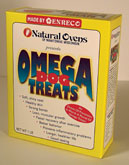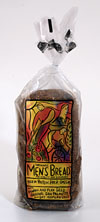
Although the company also uses flaxseed in human-oriented products such as breads, muffins, cookies and supplements, its website notes a range of animal foods and feeds such as Omega Gold™ for pigs, Omega Horseshine™ for horses, and Super Egg Stabilized Flax for chickens.

Statistically, pet foods have been the most popular category for omega fatty acid use, with references to benefits for skin and coats (presumably fur coats), the most common claim worldwide. (See article on Prepared Foods' website below.)
www.PreparedFoods.com (04/2002 Issue)
www.flax.com
www.enreco.com
www.naturalovens.com/new/index.htm

Spread it Around
Spectrum Naturals, Petaluma, Calif., and omega fatty acids have been a winning combination for some time. Organic vinaigrette salad dressings in balsamic, ginger-garlic and raspberry were introduced back in 1999 in the U.S., with a similar line turning up in the U.K. in 2000. The source is flax oil.More recently, “omega mayonnaise” has been hitting retail shelves. Spectrum Naturals introduced Organic Omega-3 Mayonnaise (shown here), “which helps provide consumers with the essential fatty acid omega-3, a nutrient that is essential to the body and must be obtained from outside food sources,” claims the company. A 16-fl.-oz. container retails for $4.99 at health food stores nationwide.
The GNPD noted that Heart Beat Foods, Div. GFA Brands, Inc. , Cresskill, N.J., introduced Smart Balance Light mayonnaise in March of this year. The label notes that the “right balance of fats helps improve cholesterol ratio.” It claims half the fat and calories of regular mayonnaise, is fortified with vitamin E and—retailing at $2.39 for a 16-fl.-oz. glass jar—is also less than half the price. The omega-3s are likely from the canola and/or soy oil, as no other primary sources are mentioned.
www.smartbalance.com/main.html
www.spectrumnaturals.com

Just for Men
For “those who have just about had it with feminine wheat products,” jests an entry on the Global New Products Database, French Meadow Bakery, Minneapolis, Minn., introduced Men's Bread at the end of 2001. High in protein, fiber, and omegas “for vitality and endurance,” the product retails in health food stores and targets...well, men.Numerous ingredients are chosen with an eye towards components that researchers are associating with certain men's health conditions. They include saw palmetto, soy germ isoflavone concentrate and flaxseed, a grain high in omega fatty acids.
The ingredient legend additionally lists some 20 organic components, primarily grains and seeds. Many—quinoa, spelt, kamut, barley, wheat and oats—have been incorporated after they have been sprouted.
www.frenchmeadow.com

Bar None
What do honey peanut, chocolate raspberry, apple cinnamon crunch and fish oil have in common? The last ingredient is the source of omega-3s for ZonePerfect Nutrition Company's, Beverly, Mass., line of sweet flavored nutrition bars (three of which are mentioned here).A call-out on the front label of the “all-natural, patented” Lemon Yogurt nutrition bar notes the presence of 3mg of the essential fatty acid. The blurb successfully competes for attention with another, noting the presence of soy protein.
The company also introduced a “Heart Healthy Formula” omega-3 dietary supplement containing 160mg EPA and 107mg DHA from “molecular distilled fish oil.”
www.zoneperfect.com

Sidebar: Opting for Omegas
Judging by the number of new products entering the marketplace that call attention to their omega-3 and -6 fatty acids content, these nutritional components are going mainstream. Perhaps the greatest testimony to their healthfulness has been the entry of omega-containing infant formulas into the global market. Mead Johnson Nutritionals, Evansville, Ind., and Ross Products, a division of Abbott Laboratories, Abbott Park, Ill., introduced several in the U.S. this last year.At least a few of the formulas use DHA (an omega-3) derived from Crypthecodinium cohnii, an algae, and AA (an omega-6) derived from Mortierella alpina, a fungus, which are vegetarian sources of the lipids. Fish oils are another important source of purified omega-3 fatty acids.
Addition of such lipids works most easily in products that already have a liquid fat component, says Jane Crowther, senior director of technology with an omega-3 fatty acid supplier. The easily-oxidized, polyunsaturated fats are best incorporated into products toward the end of processing, to minimize exposure to heat, light and air. Well-packaged products, with shorter shelf lives, also lessen the challenge.
Shorter chain omega-3s and some -6s also are found in high levels in grains and their oils (such as soy, canola, flaxseed, hemp and walnuts), among other sources. These provide manufacturers options for increasing the polyunsaturated fatty acid content of a food.
Website Resources:
www.nal.usda.gov/fnic/foodcomp/Bulletins/faq.html#omega —
USDA information
http://216.185.112.5/presenter.jhtml?identifier=4632 —
American Heart Association

Sidebar: Going Global
Milk and omega fatty acids go together like milk and cookies...at least according to Nestle. In September, 1999, Mintel's GNPD tracked Nestle USA's, Glendale, Calif., introduction of Leite Omega Plus-branded canned and powdered milk in Brazil. Fortified with vitamins, omega-3 and -6, the product is “designed to reduce cholesterol, aid blood circulation, and [best of all] help your heart beat happily.” The product apparently experienced enough success to encourage the company's introduction of an Omega Plus-branded drinkable, as well as a cup yogurt and a cream cheese in early 2000—in the same country.Roll-outs of the brand continued around the world with various versions of high-calcium, reduced fat milks with “omega-3 and -6 'heart-friendly' fatty acids” appearing in Malaysia, Singapore, Argentina, Philippines, Hong Kong (pictured) and Mexico, among other countries. Claims as to cardiovascular and cholesterol level benefits are common. In the first part of 2002, Malaysia saw a honey-flavored Neslac milk powder “for babies from three years onwards.” BL bifidus, iron, omega-3 and -6, and calcium round out the nutritional profile.
Ingredient statements generally list “vegetable oil mix (patent pending),” canola and/or corn oil as key components.
Multinational corporations touting the presence of such nutritional components help educate consumers on their benefits.
www.nestle.com.ph/brandnews10.htm
 Claudia Dziuk O'Donnell is Chief Editor and Associate Publisher of Prepared Foods magazine including its NutraSolutions and Culinary sections. Her responsibilities include determining the editorial content of the print publication and the New Products Conference.
Claudia Dziuk O'Donnell is Chief Editor and Associate Publisher of Prepared Foods magazine including its NutraSolutions and Culinary sections. Her responsibilities include determining the editorial content of the print publication and the New Products Conference.